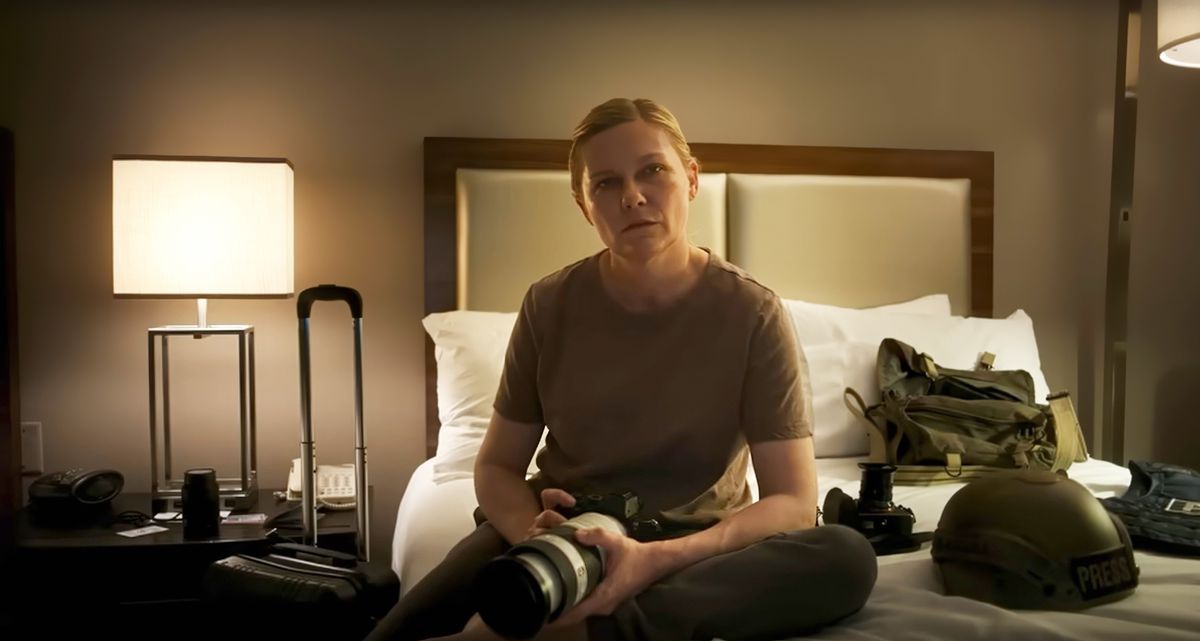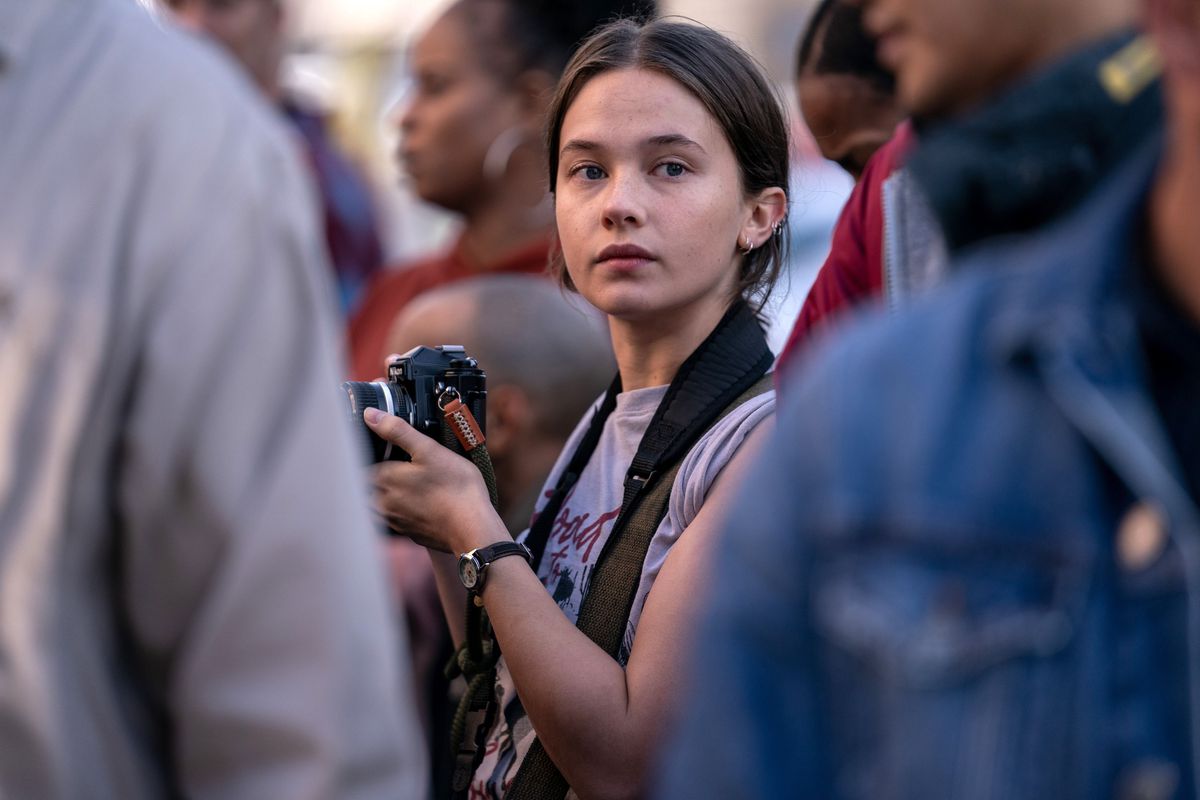Debates about the Civil War ignore Kirsten Dunst’s most important scene
Alex Garland’s A24 film Civil war has sparked a major, circular online debate over the way Garland frames his story, with minimal background details on what led to the titular civil war or what the country’s various factions stand for. The argument over how, if, and to what extent the film represents the real state of 2024 America has overshadowed much of the conversation Garland actually wanted viewers to have after seeing his film. And in particular, it ignores some of the film’s finer nuances, like the pivotal moment that truly defines it Civil war‘s story.
Civil war focuses on two photographers: war-weary photojournalist Lee Miller (Kirsten Dunst) and naive but experienced newbie Jessie (Priscilla star Cailee Spaeny). When Lee and her old writing partner Joel (Wagner Moura) take a trip to Washington, DC, Jessie tries to join them, along with aging journalist Sammy (Stephen McKinley Henderson). Lee and Joel hope to interview the president (Nick Offerman) before separatist forces take the capital. Jessie and Sammy want to make sure they are in the right place to witness and report on the new, pivotal phase of history unfolding in America.
Over the course of the film, which Garland wrote and directed, it becomes increasingly clear that Lee is burned out, depressed and suffering from PTSD. When her friends rush into battle to capture the moment, she cringes or cringes. She witnesses a raging forest fire up close with a blank stare from a thousand yards away. And she tries again and again to dissuade Jessie from going on the trip, or from doing war journalism at all. Lee’s war instincts allow her to protect Jessie from danger, and she takes charge in volatile situations, showing Jessie how a journalist can deal with threats in a war zone. But Lee also lectures and belittles Jessie, as if wishing she could retroactively talk her own younger self out of the career path she’s chosen.
Their relationship sharply mirrors the veteran-protégé relationship between two women 28 days later, one of Garland’s first film projects: his script for that film also features a hardened, experienced woman (Naomie Harris) taking a young person (Megan Burns) under her wing, with a fair amount of annoyance at the unwanted responsibility, and perhaps just a hint of relief because she can express her own fear by caring for someone else. But Civil war adds a new layer to the dynamic by making Lee and Jessie professionals in the same field: compatriots, but also potential competitors. They both seem to be idealists who want to document what is happening in America, to bring back a record of what the country has been through.
This all leads up to that key moment for Civil wara single, silent shot in the rear half of their journey.
(Ed. remark: Major spoilers ahead Civil warincluding ending spoilers.)
Photo: A24/Everett Collection
Lee and Jessie never reveal to each other why they chose a career in journalism, or why war correspondence in particular. Their personal motives, like the broader motives behind the war, must be drawn from small moments and scattered dialogue in the film. Instead, they have a heart to heart about cameras. Lee uses a digital camera; Jessie shoots on film and develops the film herself with a portable chemical kit. It’s a remarkably old-fashioned way for a young woman to ply her trade, except for the way she repurposes an iPhone (otherwise useless in a cell phone signal-free country) as a slide viewer. But Jessie is determined to capture images like her father did.
Why is a little downtime technology talk about the tools of the trade such an important conversation to capture? First, it allows Lee and Jessie to bond as equals rather than as “wise older and upstart boy,” which becomes crucial later. On the other hand, it gives the audience one of their few insights into what drives Jessie’s passion. She dives into combat situations like a zealot, oblivious to danger, but never fully expresses why photography is so important to her. Taking a moment to talk about the tactility of film gives her a softer, more human side than much of the rest of the film, where she is sometimes treated as an avatar of the audience – the newcomer to nerve-wracking situations where she’s not quite in her element. certainly knows how to behave – and sometimes treats her as bait to lure Lee into danger.
But more importantly, the exchange about cameras highlights Lee’s commitment to digital, a medium that allows her to capture and store far more images than Jessie can, but which also gives her the ability to literally erase history if she sees fit. And when she does, she provides the most telling character beat in the entire film.

Image: A24/Everett Collection
That moment comes after a harrowing encounter with a handful of heavily armed locals led by an unnamed man in camouflage and red sunglasses, played by Jesse Plemons. When those locals kill some of Lee and Joel’s press colleagues, Sammy zooms in on Joel’s truck to intervene and get their group to safety. During that rescue, however, he is shot and slowly bleeds out as they make their way to safety. Lee grimly takes a photo of his body, slumped in the driver’s seat, a sheet of his blood spread across the side of the truck.
And then she quietly looks at that image on her camera screen and decides to delete it.
Like so much inside Civil war, this moment never gets a big expository speech where Lee reveals what she’s thinking. It is very likely that different viewers will see radically different motives at that moment. (That’s fine; Garland says he prefers to let people get what they want from his films.) Lee offers her friend some final dignity by not passing on an image of his corpse to her Reuters news agency and making a to take a picture of? a product to sell? Or is she just showing once again that she is tired of war, tired of death, and tired of witnessing atrocities on behalf of others? Is she deleting the photo for her own good, because she never wants to look at Sammy’s body again? And if so, is it because she is to blame for the brutal things she said to him before the journey began, or because she survived and he didn’t? Or is it something completely different? The details depend on your interpretation.
What is clear and unequivocal at this point, however, is that Lee is effectively choosing to edit the national record of the war, erasing this one image and ensuring that it is something the future will never see. Sammy will be buried, the truck will be cleaned and for most people life will move on. Lee’s job is to capture moments like this so that they will not be forgotten, so that other people in other places can understand and experience the war and its costs. But she decides at that moment, out of guilt, respect or exhaustion, to remove Sammy’s death from the record. This moment shows how much power journalists have to shape a story, and how their responsibility can be divided between what they want for their audience and what they want for their subjects. It’s also a powerful touch of character building, with Lee exerting control over the story for her own private reasons.

Image: A24/Everett Collection
That scene is all the more important because of the way it sets up the final moments of the film. During the final raid on the White House, Jessie recklessly charges into the line of fire again, and Lee is fatally shot while carrying her to safety. Lee dies so that Jessie can live, and it’s the obvious capstone to a story about one generation passing the torch to the next – a cynic leaving the stage to make way for an idealist who will probably eventually will become a cynic if she lives long. enough.
Jessie responds to the moment by taking her own photo of Lee’s body, and in turn memorializes her as part of the record. We see that photo taken and see the photo itself, implying that the image survived the sometimes risky process of film development and printing. It’s a fascinating parallel: two different journalists making choices about how to report on the death of a colleague who saved their life, and how to share that death with the world. The choices of both women are in accordance with their character and their response to war – one turns away from it, the other records it for posterity at all costs.
Civil war doesn’t tell the audience what to make of these choices. That’s Garland’s style these days, for better or for worse: he throws images onto the screen and leaves it up to the individual viewers to discuss and decide where he wants to go. Often the things he leaves out or leaves out are more important to the story he tells than the things he chooses to elaborate on.
But while the nature and causes of the war are known Civil war are definitely worth talking about, the small, personal story beats where people make important choices are just as important. Lee’s moment with Sammy’s photo is a small snippet of the story, easily overlooked in the cacophony of the larger conflict. But it’s also the moment that marks the end of the film, and it reveals the most about Garland’s intentions. Civil war is not just a film about what choices led the country to war, or what choices different states made about who to ally with and what goals to pursue. It is about individual choices, both in and out of a crisis, and how those choices influence the future.
Garland is not vilifying Lee for removing her memento of a life-saving friend. He also doesn’t judge Jessie for seizing the moment and documenting her loss. But he does show how different two people can be, even in the same profession, in the same conflict, at the same moment in history – and all in just a handful of wordless shots.
